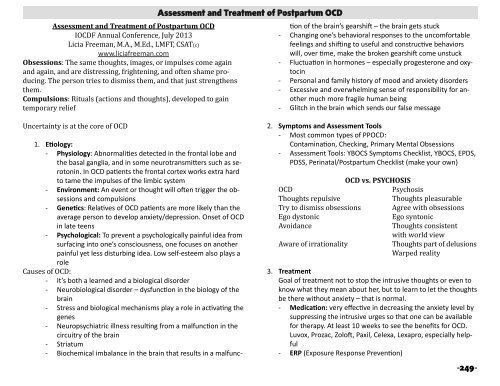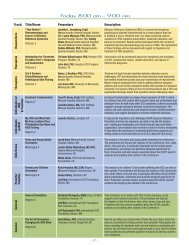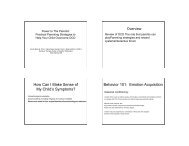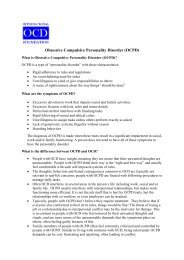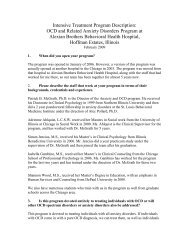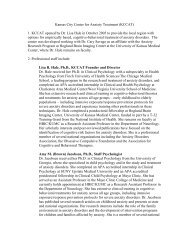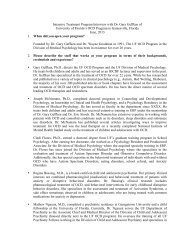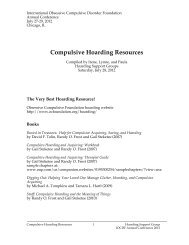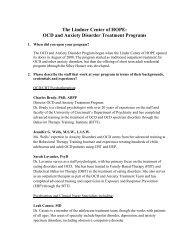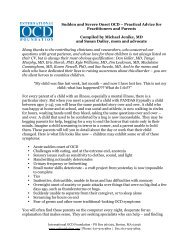perfectionism and - Obsessive-Compulsive Foundation
perfectionism and - Obsessive-Compulsive Foundation
perfectionism and - Obsessive-Compulsive Foundation
Create successful ePaper yourself
Turn your PDF publications into a flip-book with our unique Google optimized e-Paper software.
Assessment <strong>and</strong> Treatment of Postpartum OCD<br />
IOCDF Annual Conference, July 2013<br />
Licia Freeman, M.A., M.Ed., LMFT, CSAT(c)<br />
www.liciafreeman.com<br />
Obsessions: The same thoughts, images, or impulses come again<br />
<strong>and</strong> again, <strong>and</strong> are distressing, frightening, <strong>and</strong> often shame producing.<br />
The person tries to dismiss them, <strong>and</strong> that just strengthens<br />
them.<br />
Compulsions: Rituals (actions <strong>and</strong> thoughts), developed to gain<br />
temporary relief<br />
Assessment <strong>and</strong> Treatment of Postpartum OCD<br />
1. Etiology:<br />
- Physiology: Abnormalities detected in the frontal lobe <strong>and</strong><br />
the basal ganglia, <strong>and</strong> in some neurotransmitters such as serotonin.<br />
In OCD patients the frontal cortex works extra hard<br />
to tame the impulses of the limbic system<br />
- Environment: An event or thought will often trigger the obsessions<br />
<strong>and</strong> compulsions<br />
- Genetics: Relatives of OCD patients are more likely than the<br />
average person to develop anxiety/depression. Onset of OCD<br />
in late teens<br />
- Psychological: To prevent a psychologically painful idea from<br />
surfacing into one’s consciousness, one focuses on another<br />
painful yet less disturbing idea. Low self-esteem also plays a<br />
role<br />
Causes of OCD:<br />
- It’s both a learned <strong>and</strong> a biological disorder<br />
- Neurobiological disorder – dysfunction in the biology of the<br />
brain<br />
- Stress <strong>and</strong> biological mechanisms play a role in activating the<br />
genes<br />
- Neuropsychiatric illness resulting from a malfunction in the<br />
circuitry of the brain<br />
- Striatum<br />
- Biochemical imbalance in the brain that results in a malfunction<br />
of the brain’s gearshift – the brain gets stuck<br />
- Changing one’s behavioral responses to the uncomfortable<br />
feelings <strong>and</strong> shifting to useful <strong>and</strong> constructive behaviors<br />
will, over time, make the broken gearshift come unstuck<br />
- Fluctuation in hormones – especially progesterone <strong>and</strong> oxytocin<br />
- Personal <strong>and</strong> family history of mood <strong>and</strong> anxiety disorders<br />
- Excessive <strong>and</strong> overwhelming sense of responsibility for another<br />
much more fragile human being<br />
- Glitch in the brain which sends our false message<br />
Uncertainty is at the core of OCD<br />
2. Symptoms <strong>and</strong> Assessment Tools<br />
- Most common types of PPOCD:<br />
Contamination, Checking, Primary Mental Obsessions<br />
- Assessment Tools: YBOCS Symptoms Checklist, YBOCS, EPDS,<br />
PDSS, Perinatal/Postpartum Checklist (make your own)<br />
OCD vs. PSYCHOSIS<br />
OCD<br />
Psychosis<br />
Thoughts repulsive<br />
Thoughts pleasurable<br />
Try to dismiss obsessions Agree with obsessions<br />
Ego dystonic<br />
Ego syntonic<br />
Avoidance<br />
Thoughts consistent<br />
with world view<br />
Aware of irrationality<br />
Thoughts part of delusions<br />
Warped reality<br />
3. Treatment<br />
Goal of treatment not to stop the intrusive thoughts or even to<br />
know what they mean about her, but to learn to let the thoughts<br />
be there without anxiety – that is normal.<br />
- Medication: very effective in decreasing the anxiety level by<br />
suppressing the intrusive urges so that one can be available<br />
for therapy. At least 10 weeks to see the benefits for OCD.<br />
Luvox, Prozac, Zoloft, Paxil, Celexa, Lexapro, especially helpful<br />
- ERP (Exposure Response Prevention)<br />
-249-


